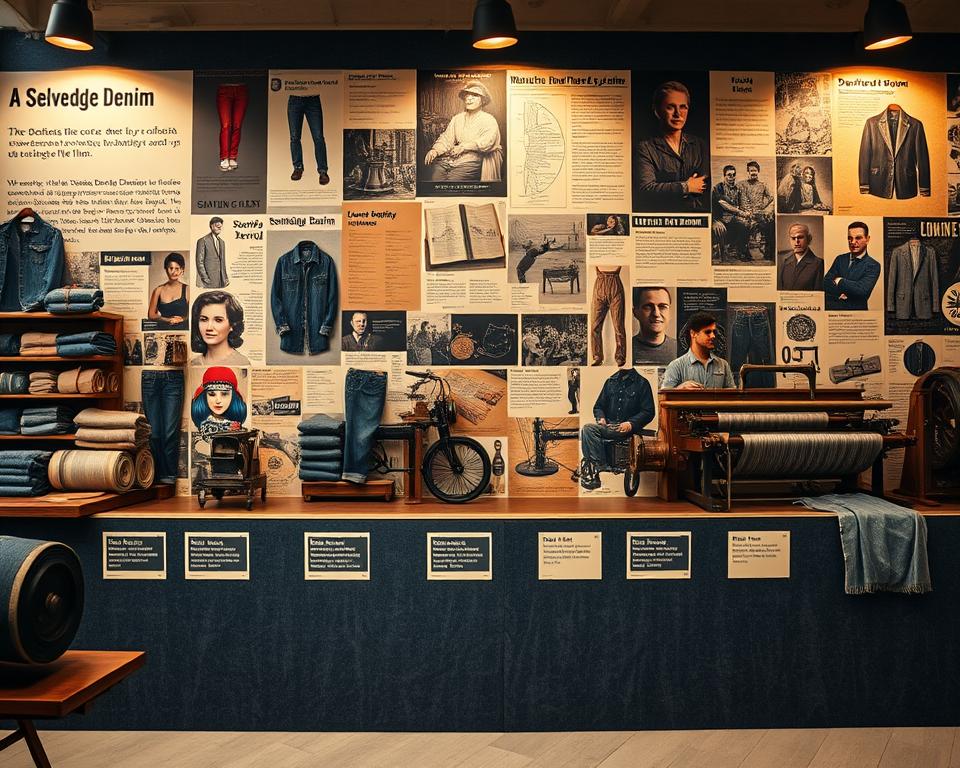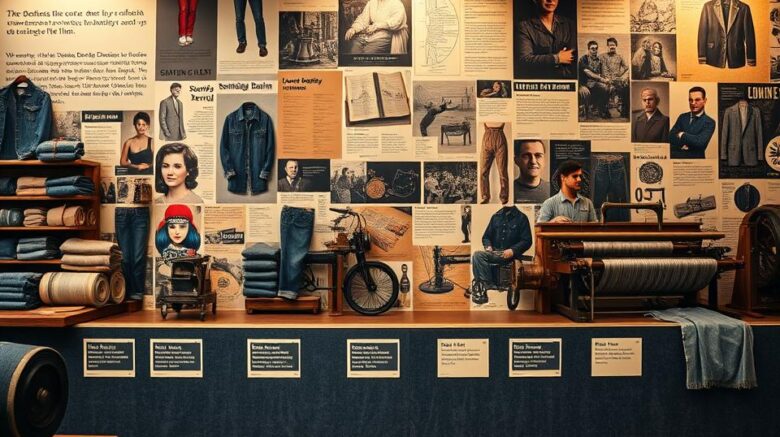A Comprehensive Guide for Premium denim Selvedge Fabric
Have you ever pondered the reason some pants feel as though they are built for endurance eternity? The secret lies in the elements and skill. For example, the increasing popularity of premium selvedge. This isn’t just any fabric—it’s a testament to superiority and legacy.
Today, a growing number of people are opting for these everlasting textiles for their durability and iconic selvedge denim fabric allure. Be it that you are a do-it-yourself sewist or a denim enthusiast, there’s a unique quality about using high-quality cotton and thread. It goes beyond merely creating trousers; it centers on crafting a narrative.
At Core Fabrics, we’ve selected a range of 14.25oz organic cotton and elastic options. These materials are ideal for a spectrum ranging from raw jeans to designer jacket designs. Ready to explore the universe of premium fabrics? Let’s dive in.
Defining Denim Selvedge Fabric?
Why do particular trousers stand out with their signature, self-finished seams? The key is found in the selvedge denim, a high-quality fabric celebrated for its durability and retro appeal. Differing from conventional textiles, this type of fabric is crafted with time-honored methods that have endured through ages.
Understanding Selvedge Denim
Selvedge denim is created using retro shuttle looms, which produce narrow widths of about 30-35 inches. The looms interlace the textile in a way that creates self-finished seams, often marked by a characteristic red line. Such a process guarantees the fabric is firmly crafted and highly durable.
Current looms, in contrast, yield wider material but fall short of the same level of craftsmanship. Minor flaws in selvedge, like twists in the leg or irregular surfaces, are accepted as part of its charm. This approach, known as “wabi-sabi”, honors the beauty of organic flaws.
Production of Selvedge Denim
The creation of selvedge denim involves a detailed process. Shuttle looms interlace the filling yarns back and forth, resulting in a dense and robust textile. This process stands in contrast with modern looms, which emphasize speed and efficiency over quality.
Labels such as Karson Denim preserve vintage Japanese weaving techniques from the 90s. They deliberately incorporate imperfections to maintain the genuineness of the material. All products is assessed on a four-point system, confirming it meets the top criteria of excellence.
| Attribute | Selvedge Denim | Current Denim |
|---|---|---|
| Width | 30-35 inches | 60+ inches |
| Weaving Process | Shuttle Loom | Contemporary Loom |
| Surface | Irregular, Flawed | Consistent |
| Sturdiness | Exceptional | Average |
“The charm of selvedge is found in its flaws—each irregularity speaks of skill and legacy.”
The Background of Selvedge Denim
From humble beginnings to global acclaim, the tale of these materials is vibrant and moving. Initially designed as rugged attire in the 17th-century France evolved into a mark of classic elegance and excellence.
Beginnings in Craftsmanship
The foundation of this material reaches back to Nîmes, France, where it was dubbed “serge de Nîmes.” Originally designed for the working class, it was crafted out of sturdy cotton and yarn. Its strength made it a favorite among laborers during the Gold Rush.
By the 20th century, it had evolved into a staple for jeans. The ending of the Cone Mills White Oak plant served as a catalyst. This change enabled Japanese artisans to restore classic fabric-making practices.

Modern Developments in Denim
After World War II, Japan developed a deep appreciation for old-school American culture. Artisans repaired classic looms to manufacture authentic reproductions. This devotion to craftsmanship guaranteed the perseverance of selvedge as a specialty product.
Today, advancements from Italy and Turkey have introduced environmentally conscious mixtures and stretch variants. These modernizations have widened the attraction of this timeless textile. At Core Fabrics, we source globally, from Montréal to Asia, to bring you the best quality.
“Selvedge’s story is a celebration of the lasting worth of excellence and heritage.”
The Benefits of Selvedge Denim?
What makes selvedge denim distinguish itself in the realm of superior materials? Its special characteristics and unmatched durability make it a favorite among lovers and stylists alike. Whether you’re crafting trousers or a tailored jacket, this material offers a blend of tradition and updated style.
Distinctive Attributes of Selvedge
Selvedge denim is renowned for its firm interlacing, which enhances ripping resistance and wear patterns. In contrast to common fabrics, selvedge denim material is produced using traditional shuttle looms, resulting in a denser and exceptionally sturdy material. In doing so, it secures that every item possesses a distinct surface and personality.
Here’s what makes it special:
- Hairy, rigid raw denim contrasts with pre-washed comfort stretches.
- Through sanforization, sizes become reliable, while natural variants entail a shrink-to-fit adventure.
- Weight options range from 9.5oz Eco Finish to 14.25oz Organic, suited for diverse applications.
Robustness and Endurance
One of the standout features of selvedge denim is its long life. The dense fabric structure both reinforces strength and permits characteristic wear patterns over time. This renders it a valuable investment for those in pursuit of enduring style.
Key points to consider:
- Fabrics weighing between 12oz and 14oz are perfect for form-fitting jackets and jeans that mellow with time.
- Opt for the 14.25oz True Indigo for traditional jean lifespan.
- Green alternatives, including recycled cotton with indigo blends, contribute to a sustainable collection.
At Core Fabrics, our collection includes a variety of options to suit your needs. From raw to sanforized, each piece is crafted to deliver exceptional quality and value.
Selvedge vs. Wide Denim: A Comparison
In the creation of robust and fashionable apparel, the decision of material plays a crucial role. Two common choices include selvedge and wide denim, each with unique characteristics. Knowing how they differ assists in selecting the ideal material for your creation.
Contrasting Weave Techniques
Selvedge denim is produced using traditional shuttle looms, producing slim widths of 30-35 inches. This selvedge denim jacket technique generates tightly woven edges, often featuring a characteristic red line. In contrast, wide denim is produced using modern projectile looms, producing spans of 60+ inches.
Shuttle looms are slower, producing about 3 meters per minute, while contemporary projectile looms achieve up to 30m per minute. This difference in speed impacts both the expense and the finish of the final product.
Benefits and Drawbacks
Selvedge denim is celebrated for its superior quality and strength. Its slender dimension makes it ideal for creations where exposed edges or decorative patches are required. However, it can be costlier, generally priced at $23 per meter.
Wide denim is economical, typically costing $8 per half-meter. Its wider width minimizes excess, well-suited to big-scale works like interior décor projects. However, it does not feature the distinctive selvage detail of selvedge.
| Feature | Selvedge Denim | Wide Denim |
|---|---|---|
| Measurement | 30-35 inches | 60+ inches |
| Weaving Process | Traditional Shuttle | Modern Projectile |
| Production Speed | 3 meters per minute | 30 meters per minute |
| Price | $23/meter | $8/half-meter |
When precise, structured edges are required—as in Grainline Thayer jackets—selvedge wins out. For larger projects, wide denim offers better value and efficiency. Evaluate your project specifications to choose wisely.
Maximizing Your Selvedge Denim
Crafting with high-end textiles raises your projects to a new standard. Whether you’re crafting jeans, blazers, or skirts, grasping fabric quantities, proper sewing methods, and maintenance guarantees a polished result. Let’s explore the optimal use of this everlasting textile.
Yardage Needed for Jeans and Jackets
It is essential to compute the correct fabric amount when designing your creation. Approximately 3-3.3 yards is necessary for men’s jeans, considering defects and shrinkage. Trucker jackets typically require 3.3 yards, while a skirt often needs 2 yards.
Creative pattern placement can help manage imperfections in the material. Rather than avoiding imperfections, incorporate them into your pattern for distinctive style.
| Garment | Fabric Needed |
|---|---|
| Men’s Jeans | 3–3.3 yards |
| Trucker-Style Jacket | 3.3 yards |
| Dress | 2 yards |
Tips for Sewing and Care
The correct gear and skills secure a refined outcome. Opt for #70–110 needle sizes and machine attachments suitable for thick fabrics. Use Gütermann rPET thread for effective contrast stitching.
Additional advice includes:
- Employ a tailor’s clapper to achieve crisp creases without gloss.
- Core Fabrics provides denim kits with topstitch thread, rivets, and 9mm buttons for that expert touch.
- For structured edges, like those in jackets, selvedge is the preferred choice.
Proper care extends the life of your creations. Limit washing and allow to air dry for optimal durability. Adhering to these practices will sustain your creations for years.
The Bottom Line
Using superior fabrics goes beyond mere durability—it’s about instilling personality. Selvedge denim epitomizes this ideology, blending artisanal charm with enduring excellence. Whether you’re sewing jeans or a structured jacket, this material tells a story with every stitch.
With Core Fabrics, unleashing your creative potential is effortless. Experience our swatch service to gauge texture and weight prior to purchase. Furthermore, take advantage of free shipping for orders above $150 USD in North America.
Eco-friendly mixtures and classic washes are paving the way for the next generation of cotton fabrics. These trends offer new ways to add sustainability and style to your wardrobe.
Prepared to immerse yourself in superior fabrics? Shop now and discover the value of crafting with purpose. Your next project could be a timeless piece that lasts for years to come.
